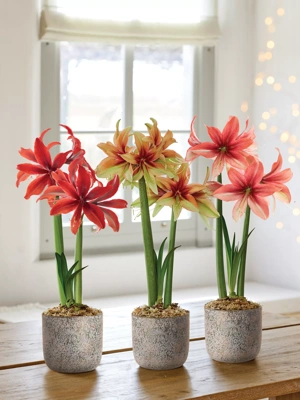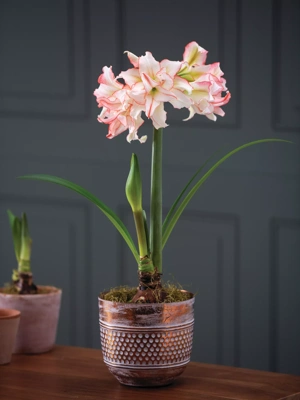Amaryllis: A Tale of True Love and Horticultural Wonder
 Bold, brilliant amaryllis brighten holiday decor and make welcome gifts.
Bold, brilliant amaryllis brighten holiday decor and make welcome gifts.Greek mythology brings us the story of Amaryllis, a love-struck maiden who longed for the handsome but cold-hearted Alteo. Desperate to win his love, she pierced her heart with a golden arrow and then visited his cottage daily, shedding drops of blood along the way. On the thirtieth day, beautiful scarlet flowers bloomed along the path. Alteo was enamored, Amaryllis' heart was healed, and our favorite holiday bloom got its name. That is, until it was reclassified in the 1800s under the genus Hippeastrum.
 Amaryllis are available in a wide range of flower colors, shapes, and sizes.
Amaryllis are available in a wide range of flower colors, shapes, and sizes. Adjustable Amaryllis Stake
Adjustable Amaryllis StakeWhatever you call them (and we'll call them amaryllis here), these dramatic tropical blooms herald the holidays with a natural beauty that only a living plant can bring. Here are 12 things you might not know about amaryllis:
- Amaryllis means to sparkle in Greek.
- Hippeastrum is derived from the Greek words for horse and star.
- In nature, amaryllis bloom in spring or summer, but are commonly forced into early bloom for the holidays.
- The U.S. imports more than 10 million amaryllis bulbs every year, mainly from Holland and South Africa.
- Plant breeders have developed more than 600 named varieties!
- Amaryllis reproduce by growing "daughter" bulbs next to the "mother" bulbs.
- It takes three to five years for a daughter bulb to reach a marketable size.
- You can grow amaryllis from seed, but it can take up to six years for them to reach maturity and produce flowers.
- Amaryllis are tender perennials; most are hardy outdoors only in zones 9 to 11.
- Properly cared for, an amaryllis plant can live for 75 years!
- Amaryllis make dramatic and long-lasting cut flowers.
- The genus Hippeastrum has yielded several substances with medically useful properties, one of which has shown promise as a treatment for Alzheimer's disease.
Last updated: 08/21/2023
Print this Article:
Related items
Get the Dirt
Stay up to date on new articles and advice. Please fill out the information below.














